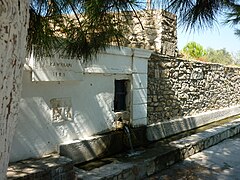Kamilari
|
Local community Kamilari Τοπική Κοινότητα Καμηλαρίου (Καμηλάρι) |
||
|---|---|---|
|
|
||
| Basic data | ||
| Country |
|
|
| region | Crete | |
| Regional district | Heraklion | |
| local community | Festos | |
| Parish | Tymbaki | |
| Geographic coordinates | 35 ° 2 ' N , 24 ° 47' E | |
| Height above d. M. |
110 m |
|
| surface | 10.128 km² | |
| Residents | 550 (2011) | |
| Population density | 54.30 inhabitants / km² | |
Kamilari ( Greek Καμηλάρι ( n. Sg. )) Is a local community on the island of Crete . It is located three kilometers southwest of the Phaistos archaeological site and belongs to the Festos municipality as part of the Tymbaki municipality .
The village of Kamilari
The main town lies on the three hills Evgora, Goulas and Alevrota and overlooks the Messara plain . The district of Metochi lies north below in the plain, here the seer Epimenides is said to have lived once . The main source of income for the 379 inhabitants is tourism. The name of the place is derived from the Byzantine word Kamilaris ('camel rider', 'camel driver').
Settlements
The villages still belong to the locality of Kamilari
- Agios Ioannis (Άγιος Ιωάννης): 65 inhabitants
- Kalamaki (Καλαμάκι): 106 inhabitants
Tholos tomb
A Minoan cemetery is located on a hill in the Gligori Korphi land one kilometer north of Kamilari . In addition to simpler graves, two Tholos graves were found here, one of which was found in a poor state of preservation. The well-preserved Tholos tomb with an inner diameter of 7.65 meters is worth seeing. It was excavated in 1957 by the Italian archaeologist Doro Levi . The grave was found in the Older Palace Period (Middle Minoan IB) around 1900 BC. And was first used up to Middle Minoan II. In the post-palace period (Late Minoan III A) the grave was used again.
construction
In front of the entrance to the grave was a paved forecourt from which one entered a corridor. On both sides of the corridor there were a total of four rooms that were used for the cult of the dead and as an ossuary . From the east one entered the Tholos through a low entrance, which could be closed with the stone slab still in place. The corpses of the deceased were deposited here. When the body was completely disintegrated, the bones were taken to the ossuary to make room for further burials.
Finds
The most important find is a clay model that probably depicts four deceased people, to whom sacrifices are made and provides insight into the Minoan cult of the dead. Two other clay models were also found, one showing four dancers at a circle dance , the other two priestesses at a sacrificial table. A terracotta sarcophagus, ceramics, seals and jewelry were also found.
photos
- Clay model of a Minoan sacrificial scene from the Tholos tomb, is now in the Heraklion Archaeological Museum
Web links
- Tomb of Kamilari at Minoer.net
- Kamilari at interkriti.org
- Tomb of Kamilari (with floor plan) at www.minoancrete.com (en)
Individual evidence
- ↑ a b Results of the 2011 census at the National Statistical Service of Greece (ΕΛ.ΣΤΑΤ) ( Memento from June 27, 2015 in the Internet Archive ) (Excel document, 2.6 MB)
- ^ Siegfried Lauffer (ed.), Greece, Lexicon of historical sites. , Augsburg 1999, ISBN 3-8289-4144-3 , p. 299
- ↑ Hans-Günter Buchholz , Vassos Karageorghis : Altägäis and Altkypros. Tübingen 1971, ISBN 3 8030 1000 4 , p. 40
- ^ Klaus Gallas: Crete, DuMont art travel guide. Cologne 1988, ISBN 3-7701-1729-8 , pp. 31, 118, 122 and 124.
- ↑ Eberhard Fohrer: Crete. Erlangen 2009, ISBN 978-3-89953-453-5 , p. 252




